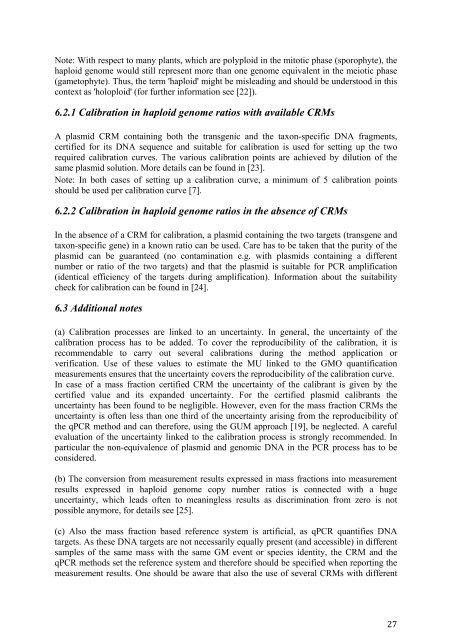final%20report%20online%20upd
final%20report%20online%20upd
final%20report%20online%20upd
Create successful ePaper yourself
Turn your PDF publications into a flip-book with our unique Google optimized e-Paper software.
Note: With respect to many plants, which are polyploid in the mitotic phase (sporophyte), the<br />
haploid genome would still represent more than one genome equivalent in the meiotic phase<br />
(gametophyte). Thus, the term 'haploid' might be misleading and should be understood in this<br />
context as 'holoploid' (for further information see [22]).<br />
6.2.1 Calibration in haploid genome ratios with available CRMs<br />
A plasmid CRM containing both the transgenic and the taxon-specific DNA fragments,<br />
certified for its DNA sequence and suitable for calibration is used for setting up the two<br />
required calibration curves. The various calibration points are achieved by dilution of the<br />
same plasmid solution. More details can be found in [23].<br />
Note: In both cases of setting up a calibration curve, a minimum of 5 calibration points<br />
should be used per calibration curve [7].<br />
6.2.2 Calibration in haploid genome ratios in the absence of CRMs<br />
In the absence of a CRM for calibration, a plasmid containing the two targets (transgene and<br />
taxon-specific gene) in a known ratio can be used. Care has to be taken that the purity of the<br />
plasmid can be guaranteed (no contamination e.g. with plasmids containing a different<br />
number or ratio of the two targets) and that the plasmid is suitable for PCR amplification<br />
(identical efficiency of the targets during amplification). Information about the suitability<br />
check for calibration can be found in [24].<br />
6.3 Additional notes<br />
(a) Calibration processes are linked to an uncertainty. In general, the uncertainty of the<br />
calibration process has to be added. To cover the reproducibility of the calibration, it is<br />
recommendable to carry out several calibrations during the method application or<br />
verification. Use of these values to estimate the MU linked to the GMO quantification<br />
measurements ensures that the uncertainty covers the reproducibility of the calibration curve.<br />
In case of a mass fraction certified CRM the uncertainty of the calibrant is given by the<br />
certified value and its expanded uncertainty. For the certified plasmid calibrants the<br />
uncertainty has been found to be negligible. However, even for the mass fraction CRMs the<br />
uncertainty is often less than one third of the uncertainty arising from the reproducibility of<br />
the qPCR method and can therefore, using the GUM approach [19], be neglected. A careful<br />
evaluation of the uncertainty linked to the calibration process is strongly recommended. In<br />
particular the non-equivalence of plasmid and genomic DNA in the PCR process has to be<br />
considered.<br />
(b) The conversion from measurement results expressed in mass fractions into measurement<br />
results expressed in haploid genome copy number ratios is connected with a huge<br />
uncertainty, which leads often to meaningless results as discrimination from zero is not<br />
possible anymore, for details see [25].<br />
(c) Also the mass fraction based reference system is artificial, as qPCR quantifies DNA<br />
targets. As these DNA targets are not necessarily equally present (and accessible) in different<br />
samples of the same mass with the same GM event or species identity, the CRM and the<br />
qPCR methods set the reference system and therefore should be specified when reporting the<br />
measurement results. One should be aware that also the use of several CRMs with different<br />
27
















